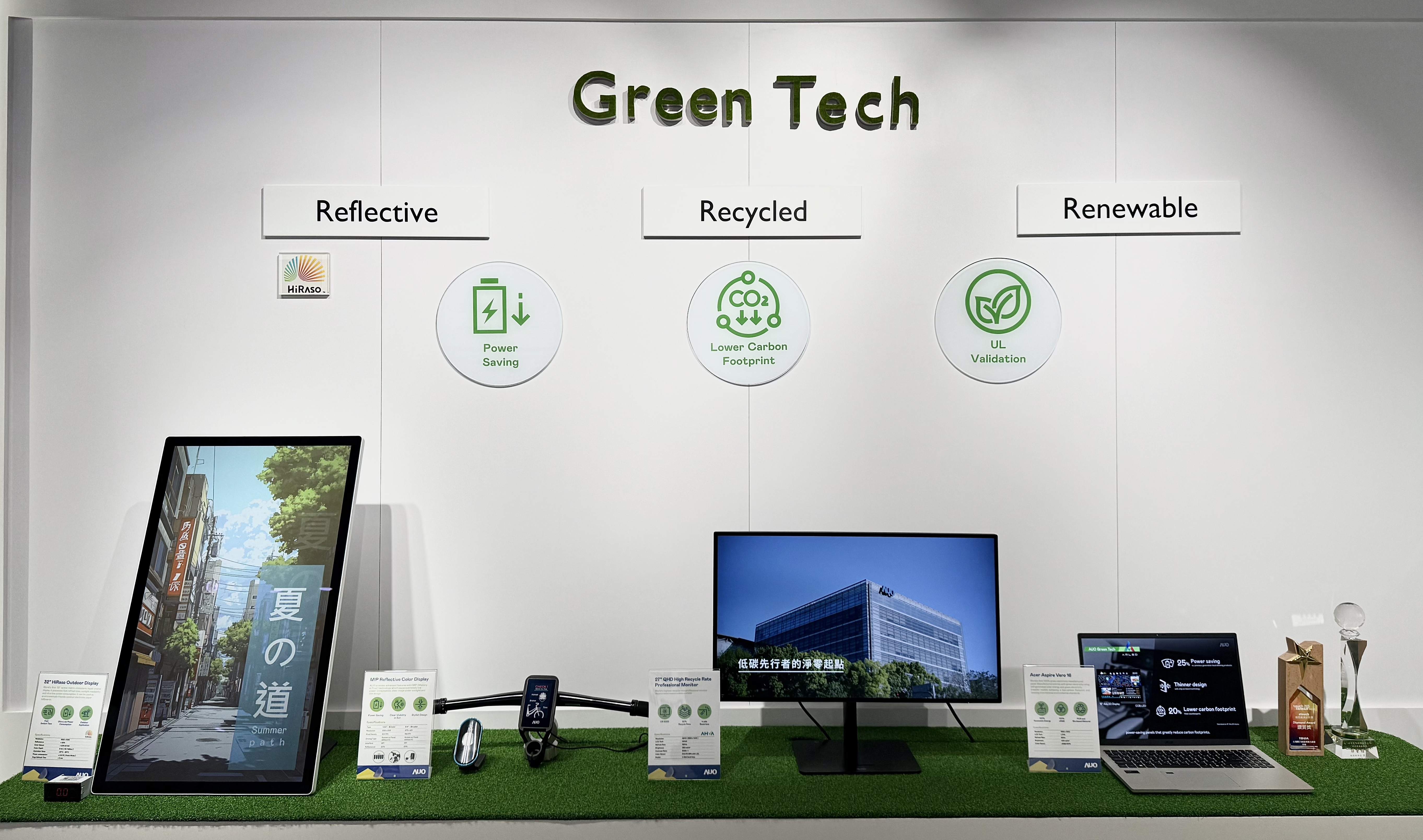In response to the global net-zero movement, the demand for sustainable products is rapidly rising. Green technology has become a key driver for businesses to tap into low-carbon opportunities and enhance brand value. AUO has long been dedicated to green R&D, demonstrating its international influence. Not only does it lead Taiwan's display industry in the number of publicly disclosed green patents, but this year, at SID Display Week 2025 (Society for Information Display) – the most authoritative global display technology event – AUO was selected to present six papers on green technology and was also invited to serve as the chair of a special topic. This highlights AUO's comprehensive strategic approach to green products.
|
Building on a stringent carbon management strategy, AUO has continuously driven product carbon reduction for the past 15 years. Through a series of research publications, AUO has pioneered a new framework for product carbon management. This not only establishes a highly credible carbon management foundation for brand clients but also enhances the transparency and traceability of low-carbon products. It showcases AUO's industry influence and competitiveness in emerging green business opportunities, along with its commitment to collaborating with clients to co-create brand value.
SID Display Week is a flagship event in the global display industry, where leading brands unveil cutting-edge technologies. This year, in response to the market's heightened focus on green technology, the event for the first time established a symposium dedicated to "Sustainable Displays and Green Technologies." AUO approached this from a comprehensive perspective, encompassing R&D, sustainability, and environmental safety. During the symposium, AUO presented a series of papers highlighting its achievements in sustainable panel products. Its research insights are based on the entire product lifecycle management, from upstream carbon inventory and product carbon footprint methodology to the innovative design of downstream green product identification indicators. This demonstrated AUO's deep technical expertise and broad vision in display panel sustainability.
AUO Developed High-Precision Carbon Footprint Methodology to Help Brands Achieve Scope 3 Carbon Management As market demand for sustainable products grows, understanding and managing product carbon footprints has become crucial for enhancing product sustainability. Within this context, one of the biggest challenges for brands and businesses operating under global supply chain structures is the calculation and management of Scope 3 carbon emissions. AUO is leading the industry by proactively establishing a product carbon management strategy. Back in 2009, AUO began investing in product carbon footprint verification. Then, in 2023, building upon ISO 14067, it independently developed the "AUO High-Precision Methodology" (APM). This created a carbon management tool that combines international standards with practical experience, more accurately reflecting carbon reduction effectiveness.
The AUO High-Precision Methodology (APM) focuses on the product's carbon footprint structure, effectively addressing international brands' need for sustainable product information and understanding. This methodology offers three core benefits: precise emission calculation, hotspot identification, and reflection of reduction effectiveness. Through highly systematized actual data collection, APM not only reveals product carbon emission structures and key hotspots but also quantifies the actual impact of various carbon reduction initiatives on product low-carbon transformation, thereby enhancing the transparency and accuracy of carbon footprint management.
Five Distinct Indicators to Help Brands Quickly Grasp Green Product Performance Building on the APM methodology, AUO has further introduced a "Green Label" to represent the environmental performance of display products in a visible way. While existing tools like the EPEAT (Electronic Product Environmental Assessment Tool) and TCO Certified primarily focus on environmental verification of end products, AUO's independently developed "Green Label" focuses more on the characteristics of the display panel industry. It covers five key indicators: Recycled Materials Use, Renewable Energy Use (in panel manufacturing), Product Energy Efficiency Improvement, Material Reduction and Manufacture Simplification, and Design for Circular Economy. These indicators not only increase the transparency of product sustainability information but also help brand clients clearly assess product environmental performance, supporting informed communication and procurement decisions. This also showcases AUO's brand values through its sustainability practices.
As a leader in the display industry and sustainability transformation, AUO has demonstrated its technological prowess and determination in sustainable product innovation through a forward-looking green technology strategy. This spans from supply chain carbon management and product carbon emission transparency to labeling systems and market communication mechanisms. The newly introduced Green Label and APM methodology not only reflect AUO's technological capability in creating carbon-competitive products for brand clients but also further solidify its crucial role in the green supply chain. AUO also hopes to deepen collaboration with brands through this standardized framework, demonstrating its leadership in defining green products in emerging markets and fulfilling its long-term commitment to co-creating sustainable value with clients.
|

AUO "Green Label" covers five key indicators: Recycled Materials Use, Renewable Energy Use (in panel manufacturing), Product Energy Efficiency Improvement, Material Reduction and Manufacture Simplification, and Design for Circular Economy. These indicators not only increase the transparency of product sustainability information but also help brand clients clearly assess product environmental performance.

AUO has demonstrated its technological prowess and determination in sustainable product innovation through a forward-looking green technology strategy. This spans from supply chain carbon management and product carbon emission transparency to labeling systems and market communication mechanisms.
|